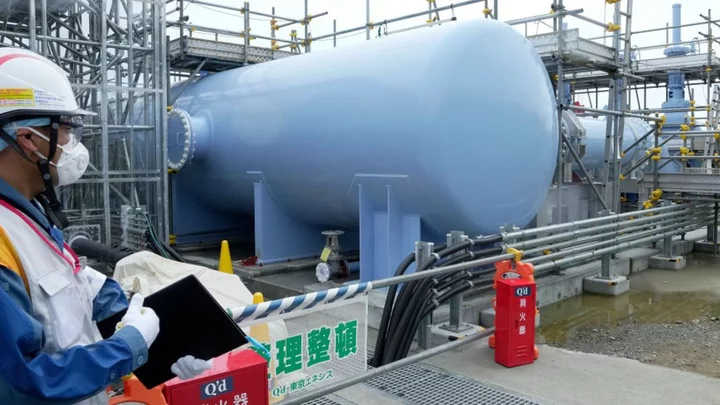A bedrock federal law designed to protect the environment and empower local communities is being weaponized to block progress on climate change, infrastructure and housing.
The battle over New York City's landmark congestion price plan is the latest example.
After more than 50 years of efforts to implement a toll program that would slash greenhouse emissions from cars and reduce congestion in lower Manhattan, the plan cleared a milestone in May, when the federal government signed off on the release of an environmental assessment.
Then, last month, New Jersey sued to block the plan, citing the National Environmental Policy Act of 1970 (NEPA). The law requires federal agencies to give a detailed assessment of the environmental impact before approving projects that could significantly alter the environmental landscape.
New Jersey said the government's analysis, which spanned more than 4,000 pages and included feedback from 80,000 public comments, was not comprehensive enough.
Congestion taxes have been tested in major cities around the world and proven to be successful, if initially controversial. European cities like London and Stockholm have seen a range of benefits, including a reduction in congestion, a drop in carbon dioxide pollution and lower rates of pediatric acute asthma cases.
But New Jersey said the Federal Highway Administration failed to adequately consider the impact that congestion pricing would have on diverting traffic to the state and harming its environment. Lawmakers want the government to conduct a more thorough analysis — which could take years.
Advocates of NEPA reform say it's ironic that New York City's congestion tax — a project intended to curb greenhouse emissions and boost mass transit — is being scuttled via a law specifically designed to improve the environment.
Unintended consequences
In the United States, conservatives have pushed to weaken environmental regulations for years. But now, more and more Democrats in Congress and left-leaning researchers are embracing the idea of streamlining the review process.
They say they want to protect the environment, but that the process needs to be modernized for the climate-change era and government isn't acting fast enough.
Some of these critics on the left say environmental review has become a labyrinth of paperwork and litigation to stop or delay key clean energy projects, raise construction costs and create uncertainty for businesses. The Democrats' sweeping Inflation Reduction Act contained billions of dollars in tax credits designed to turbocharge energy, especially clean energy, but there are concerns that NEPA procedures will create hurdles to build these projects.
"Once you take a broader climate change approach, environmental review becomes a bad tool to helping the environment," said Howard Slatkin, executive director at Citizens Housing and Planning Council, a progressive nonprofit research and education organization in New York City. "It punishes all of the things that smart growth offers," he said, including density, housing development and public transit.
"A tool that was built to stop the bulldozing of trees is getting in the way of our climate future," he said.
Reform advocates say other recent lawsuits — efforts to block expanding the number of students admitted to University of California, Berkeley; single-family housing zoning reform in Minneapolis; and affordable housing for seniors in New York City — show how environmental review procedures have become a barrier in some cases.
While projects drag on or get canceled, carbon emissions rise and the housing shortage worsens.
Slowing down government
The National Environmental Policy Act, passed by Congress in 1969 and signed into law by President Richard Nixon on January 1, 1970, was considered the Magna Carta of environmental protection law.
Congress enacted NEPA, as well as the Clean Air Act, Endangered Species Act and other foundational environmental laws in the 1970s in response to growing environmental awareness and revolts over urban renewal projects like highway construction that displaced communities.
During the New Deal and post-World War II era, newly created federal and state agencies grew, rolling out massive public works projects.
"But by the 1960s, you see a backlash both from emerging environmental movements and from communities that feel agencies are riding roughshod over them," said Paul Sabin, who teaches US environmental history at Yale University and is the author of "Public Citizens: The Attack on Big Government and the Remaking of American Liberalism."
"NEPA emerged at a time where people thought that government was doing too much," Sabin said. "It reflected an idea that we could slow change."
The goal of NEPA was to require federal agencies to take environmental considerations into account during their planning and decision-making process — a "look before you leap" approach. It also gave local communities a greater voice in government decisions. States also enacted their own equivalents of NEPA, known as "little NEPAs."
But critics say that, in practice, NEPA and state-level versions have drifted far beyond their original purpose.
While NEPA was initially intended to require review of "major" federal actions that could "significantly" affect the human and natural environment, more than 12,000 comprehensive environmental reviews are now conducted annually.
But around 98% of substantive NEPA reviews apply to projects that do not have a significant environmental impact, according to Eli Dourado, a senior research fellow at the Center for Growth and Opportunity at Utah State University.
"When you impose these big, procedural requirements on basically everything, it privileges the status quo," he said. "That's good if you start with an environmentally pristine world, but it makes new things incredibly hard to do"
These reviews have ballooned in size and often add months or years of delay to badly needed projects, including clean energy projects.
On average, a full environmental analysis now takes 4.5 years to complete.
The environmental review process has "metastasized well beyond what anyone intended it to be," Dourado said. "To me, it's clearly dysfunctional."
Reform efforts
The need to reform the environmental review process has become a bipartisan issue in recent years. But there are tensions between the competing goals of protecting the environment and also speeding up major infrastructure projects.
"This is a balancing between the need for speed and the need to protect core environmental values and the interest of communities," said Elgie Holstein, a senior director for strategic planning at the Environmental Defense Fund and a former energy adviser to Presidents Bill Clinton and Barack Obama.
There is disagreement among Democrats and Republicans about how far to go, and a split has emerged within the environmental advocacy movement over whether to support changes to NEPA.
In 2020, President Donald Trump's administration proposed a dramatic weakening of NEPA that would end the requirement for federal agencies to take climate change into account when they assess the environmental impacts of projects.
President Joe Biden's administration scrapped this proposal, but last month proposed a new rule to speed up permitting for clean energy and other infrastructure projects under NEPA. The proposals emerged from the bipartisan deal to raise the debt ceiling.
The rule would designate a lead agency for each project review and set stricter deadlines and page limits for assessments. It would also mean that projects with clear, long-lasting positive impacts do not require comprehensive environmental impact analysis.
Projects like enabling hazardous fuel reduction in an area with high wildfire risk would be more easily excluded from environmental review, the administration said.
Some environmental groups believe these reforms are needed to advance clean energy progress and other goals. But other groups fear changes will undermine key environmental protections.
"Most of the environmental community is, at a minimum, leery of these proposals and very concerned about the possibility of the fervor for building out new energy infrastructure running roughshod over NEPA," Holstein said.
While the Environmental Defense Fund supports the Biden administration's reforms to NEPA, it's against a draconian rollback of environmental review, he said.
"We don't want to throw out the baby with the bathwater."









